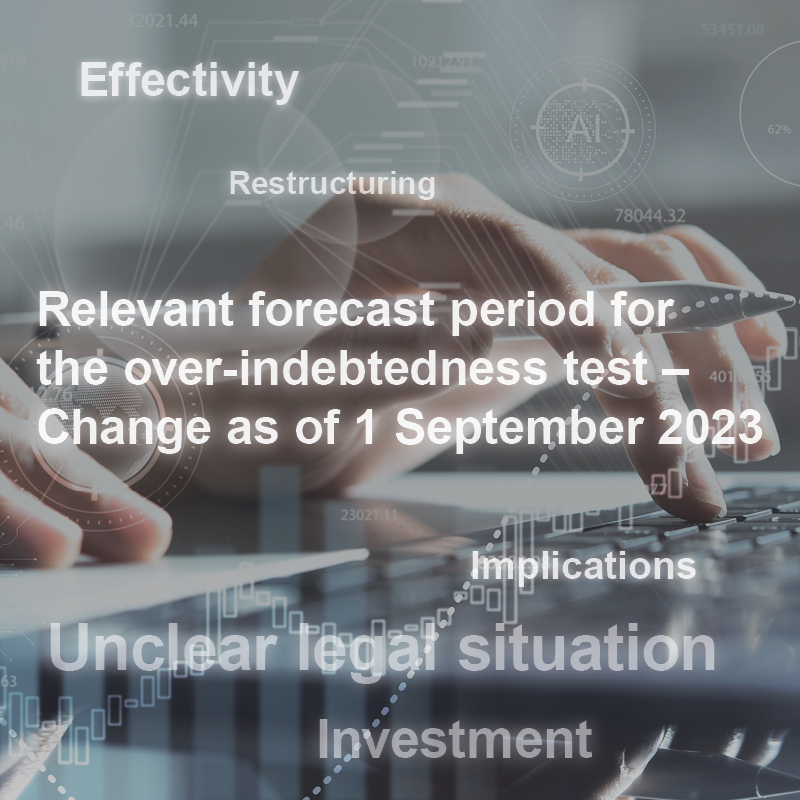05.09.2023
Relevant forecast period for the over-indebtedness test – Change as of 1 September 2023

At the end of last year, the German legislator responded to the war in Ukraine and the resulting uncertainty in planning, due in particular to the higher cost of energy, by reducing the forecast period for the over-indebtedness test for which companies must document a sufficient level of liquidity for the future from twelve to four months (for further details, please refer to our blog post from 1 February 2023 in the German language). The German Act on the Temporary Adjustment of Restructuring and Insolvency Law Provisions to Mitigate the Impact of Crises (SanInsKG, hereinafter: “Crisis Impact Mitigation Act”), which temporarily amends the German Insolvency Code (InsO), amongst other laws, continues in force until 31 December 2023. There are currently no indications that the Crisis Impact Mitigation Act will be extended.
The Crisis Impact Mitigation Act may, however, lose its practical effectiveness even before the expiry of its limited period of validity. If a company establishes less than four months before 31 December 2023 – that is, on or after 1 September 2023 – that it does not have sufficient liquidity for the twelve-month forecast period stipulated in § 19(2), first sentence, of the German Insolvency Code, which will apply again from 1 January 2024, this might have to be taken into account from as early as 1 September 2023 when examining whether the company is obliged to file for insolvency. This was already pointed out in the explanatory memorandum (BT printed matter 20/2730 and BT printed matter 20/4087). And also a press release issued by the German Federal Ministry of Justice (BMJ) with regard to the Crisis Impact Mitigation Act is to the effect that the currently reduced forecast period will be twelve months again starting from 1 September 2023. The Institute of Auditors in Germany (IDW) seems to have adopted this view in its new draft standard referred to as IDW ES 11 (margin no. 106); in any case, the Institute has not distanced itself from the statements contained in the explanatory memorandum and in the press release issued by the Federal Ministry of Justice. Unsurprisingly, the insolvency administrators’ representatives are of the opinion that “former insolvency law” should apply again from 1 September 2023.
The purpose of the Crisis Impact Mitigation Act would be an argument against the aforesaid interpretation. The plan was to relieve companies by introducing the reduced forecast period as an interim solution. A de facto reduction of the duration of application of the reduced forecast period would thwart the purpose of the Crisis Impact Mitigation Act. In addition, the wording of the Crisis Impact Mitigation Act (“until and including 31 December 2023”) is also hardly compatible with said interpretation. It appears, however, that the German legislator intended to limit the reduced forecast period until 31 August 2023; otherwise, it would be difficult to explain the respective pertinent – albeit cryptic – statements in the legislative documents and in the press release issued by the Federal Ministry of Justice.
It is essential for a company’s management board members or managing directors to have a precise legal framework with clear information about the exact obligations and deadlines for filing for insolvency. At present, however, the forecast period applicable from 1 September 2023 cannot be determined with the certainty necessary in connection with obligations to file for insolvency. Waiting until this legal issue has been clarified in court is not an acceptable option, given the considerable civil and criminal liability risks associated with the late or premature timely filing of an application to open insolvency proceedings.
Against this background, we would recommend returning to rolling integrated business planning with a planning horizon of twelve months as part of the company’s legally required monitoring systems from the beginning of September 2023, at the latest. Management should proceed on the assumption – if only for reasons of prudence – that for forecasts as to the company’s continued existence as a going concern, the twelve-month forecast period will apply again from 1 September 2023. As soon as it is no longer “highly likely” that the company will continue to exist as a going concern, which means that the company will become unable within a period of twelve months to meet its payment obligations when due, the application to open insolvency proceedings must be filed without undue delay. To avoid being liable for filing a possibly premature application to open insolvency proceedings, in particular the shareholders should be involved in the decision beforehand.
As for the planning periods for debtor-in-possession proceedings and restructuring plans, which have also been reduced by the Crisis Impact Mitigation Act with a view to facilitating access to debtor-in-possession proceedings and to stabilisation and restructuring measures, the former six-month periods are likely to apply again from 1 September 2023, instead of the current four-month periods.

Dr Boris Ober
Partner
Cologne
boris.ober@luther-lawfirm.com
+49 221 9937 18764